Uncategorized
Healthy Foods for Fall

The season of fall brings cooler weather and shorter days. As with any season, the world adjusts accordingly. Plants begin to go dormant, animals begin scrounging for food to store to get them through the upcoming winter months and humans start winterizing everything.
As fall descends on the land, it reminds us we need to start cutting back on the numerous cooling foods that are consumed during the summer months. Things like raw foods, salads, juices and fruits should be decreased because they can create too much cold in the body, according to traditional Chinese medicine. continue reading
Five Reasons to Get Acupuncture for Low Back Pain

Statistics show eight out of 10 people will experience low back pain at some point during their life. Seeking medical treatment for back pain is very common. Typically back pain is fleeting and can be easily resolved with rest, heat and an occasional anti-inflammatory like ibuprofen. However, once the damage is done, the recurrence of back pain can be as high as 50 percent. Part of this is because as we age, things like muscles and tendons become less flexible and pliable. It is also very well known in the United States, people are too sedentary and this leads to excess weight gain that can create added pressure on the body, especially the low back. continue reading
Cupping Around The World
by Jon Pontrello, LAc
A few weeks ago, I went up to Canada to take a curing class with a teacher who had travelled from Australia. This class would not be my introduction to cupping. For the last few years I have been working in a clinic where I learned how to cup and practiced regularly under the guidance of a practitioner who has been cupping since before I was born. My reasoning for taking this class is not because my glass was half empty, but rather because my glass is half full. I am fascinated by cupping because, like an acupuncture needle, a cup is a very simple tool that in the hands of a skilled practitioner can provide a very effective and economical treatment for many health problems.
Cupping is a method of using suction to create a therapeutic effect. This is most commonly done using a cotton ball mini-torch that is carefully inserted into the body of the cupping vessel so that when the flame uses up the available oxygen within the cup, a vacuum is created. When the cup is placed upon the surface of the skin a negative pressure system is created, which causes the suction effect.
Where does the therapeutic effect come from? What does suction have to do with the common cold or back pain? The answer depends on which era of medicine you ask. If you were able to summon people that lived in prehistoric times, they might tell you that the cups pull out evil spirits. We know from the times that traditional medicines of China and Greece were being put into writing around two thousand years ago that they believed the cups were having an effect on the meteorological causes of diseases such as wind and/or cold, and that they helped to move bad, old or stagnant blood. In modern times, researchers also say that cups help to increase circulation, though some people today will tell you the cups have no effect at all and that the benefit is an illusion in the imagination.
One of my favorite stories from the class was from over a century ago when a recent graduate of medical school was doing his apprenticeship with an experienced doctor. They were doing a house call in a rural area of Australia and the patient had a severe case of lumbago (back pain). The doctor asked the apprentice what to do, and the apprentice just shook his head while fumbling over his words trying to remember what he learned in school. So the doctor applied cups and soon after the patient was walking freely without pain. The apprentice was amazed, especially in light of the fact that his professors in medical school had pounded the nail into the coffin of cupping practice, saying it was a useless form of treatment.
There were many other anecdotes in class, one about a lady who got relief from the common cold, saying that she would not believe the benefit of cupping unless she had experienced it herself. Another story of a German spy who had been exposed to radiation who said that the only relief he could find was from a cupping treatment. There was a story of a cupping practitioner from Russia who emigrated to Australia who was so worried that she would not be able to buy cups where she was going that she filled up the only suitcase she could bring with cupping vessels!
One of the nights after my class, I was talking to the host of the AirBnB where I was staying. He was from Tunisia and was very excited to to find out I was learning about cupping. He was Muslim and did not know the cupping existed outside his religion. He did not know a lot about that part of his religion, so we started watching videos on YouTube and he translated them for me. In the Muslim religion, it is called hijama and it is slightly different than the cupping I have described above. They create an small incision in the skin before applying the cups so that the cups fill up with blood, it is usually only done during certain parts of the moon’s phase. It is believed to help to purify the body and mind. Hijama is a revelation of their religion. Their prophet does not claim to invent it, but rather became aware of the benefits and says it is a very valuable thing to do so he recommends it to his followers. The next day I mentioned this in class and many people were surprised to know that Muslims practiced cupping.
On the last day of class, the teacher was showing us a particular method of cupping that focused on knee pain that he had learned from a teacher in Taiwan. He said that once when he was teaching this method, one of the students said he had learned the same method from a teacher in Egypt. Before taking this class I had primarily thought of cupping as one of the many conjunctive therapies to Chinese medicine, but afterwards I’m starting to see it as an integral part to a much bigger picture than I was aware of.
On the way back from Canada the border patrol asked me what I was doing in Vancouver. I told her cupping, and she said she knew about it because of Gwyneth Paltrow. I’ve got to say I am happy that celebrities and Olympic athletes have rekindled the awareness among the public of cupping, but I also want remind people that cupping is not a passing fad like jazzercise or the south beach diet. Cupping is a timeless medicine for the wellness of everyday people.
5 Ways to Promote Sleep
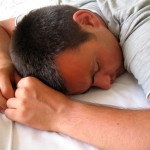 This time of year with the busy holiday season, you might find yourself having trouble sleeping. It may be difficult to fall asleep due to your mind busy thinking about all the things you have to do the next day, or you might awaken during the night and have trouble falling back to sleep. Most people need 8 hours of sleep each night for our body’s cells to recover and rejuvenate. If you have pain or other health issues, then it is especially important to get a full night of sleep. Here are some tips to help you fall asleep easily so you can be refreshed and alert the next day. If you have children then these tips could come in handy on Christmas Eve to calm those anxious little minds!
This time of year with the busy holiday season, you might find yourself having trouble sleeping. It may be difficult to fall asleep due to your mind busy thinking about all the things you have to do the next day, or you might awaken during the night and have trouble falling back to sleep. Most people need 8 hours of sleep each night for our body’s cells to recover and rejuvenate. If you have pain or other health issues, then it is especially important to get a full night of sleep. Here are some tips to help you fall asleep easily so you can be refreshed and alert the next day. If you have children then these tips could come in handy on Christmas Eve to calm those anxious little minds!
1. Start dimming your lights 45-60 minutes prior to your bedtime. A good way to automatically dim your computer screen every night is to download the f.lux free software which gradually modifies your monitor throughout the 24 hour daily cycle. It changes your monitor’s light level from its normal cool brightness in the afternoon to a warm dimmer level at night. The warmer level is also comfortable for your eyes when using your computer at night.
2. Turn off all lights except a red or orange light 30 minutes before bedtime. Your body needs darkness to increase melatonin, which is a hormone needed to help you fall asleep. Most lighting can prohibit melatonin production but warm hues of orange, yellow, and especially red allow more melatonin production than other colors. Cooler colors, on the other hand, are more blocking of melatonin, and blue is the worst offender. It is best to avoid blue light at night. There are several ways to achieve warm-colored light. Incandescent bulbs and candlelight are warm-hued lights. Avoid the newer lighting technology of LED and compact fluorescent (CF) bulbs because they emit much blue light. If you must use the cooler bulbs, then cover them with a red or orange lampshade or scarf in the evenings. The best use of lighting to help ensure a good night’s sleep is exposure to bright cool (blue) lighting during the day and dim warm (red) lighting at night. [Please note: This is a correction to how this paragraph was previously worded. I previously stated here that all light except blue light should be avoided at night, which is quite the opposite of what you should do!] More info here.
3. Start dimming all screens — computer, smartphone, TV, tablets — 2-3 hours before bedtime. These items stimulate your mind and keep you awake and alert. New research has shown that exposure to computers, iPads, e-Readers, and smartphones before bedtime can adversely affect your alertness and wakefulness the next day. Even if you are able to sleep 8 hours after using these types of screens, your sleep would most likely be of poor quality. Insufficiency of good quality sleep has been linked to greater health problems including obesity, diabetes, and cardiovascular disease. More info here.
4. Read a book at bedtime or during the night if you wake up and can’t fall easily back to sleep. Reading is calming and can promote sleep, as long as the words you read are printed on paper.
5. Massage your ears. This is a Chinese medicine technique to calm your mind, relieve stress, and promote sleep. Place your thumbs on the “front” of your ears and your index and middle fingers on the “back” of your ears. Gently rub both ears in a circular motion for 1-2 minutes, moving your fingers and thumbs to massage all surfaces of the ears, including deep inside and along the edges. This will stimulate hundreds of acupuncture points on the ears to put your body and mind into better balance. Your ears will become warm, and your brain waves will change from the beta waves of wakefulness and activity to the alpha waves of relaxation and sleep. Ear massage is also a quick way to relieve stress during the day.
Acupuncture can resolve many types of insomnia. It is one of the most common conditions we treat. Click here to read about how acupuncture can help you sleep better and to see more tips for a better night’s sleep.
Easy Pumpkin Spice Latte Recipe
Want a hot flavorful holiday beverage without venturing out into the cold to reach a coffee house? Try this very easy recipe at home. If you don’t quite have all the ingredients, you can try it anyway with what you have on hand. It’s even good without the pumpkin.
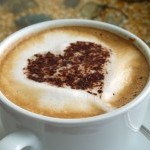 Ingredients to make 2 servings:
Ingredients to make 2 servings:
2 Tbs pumpkin puree (canned or fresh)
2 cups milk of your choice *
1 or 1½ Tbs sugar (or substitute with sweetener of your choice) **
2 tsp vanilla extract
½ tsp pumpkin pie spice (or dash of ground cinnamon, nutmeg, ginger, clove)
1-2 shots espresso or ¼ cup strong coffee
* Milk may be cow’s milk (whole or lower in fat), almond milk, rice milk, or soy milk. Coconut milk from a carton is my favorite because its consistency is similar to that of whole milk.
** Sweetener may be honey, maple syrup, or agave
Optional: Make a non-coffee version by omitting the coffee/espresso
Instructions:
- Heat all ingredients except coffee/espresso in saucepan on medium heat. Stir constantly with whisk. Gently warm mixture to a hot simmer. Do not boil.
Optional: Pour the heated milk mixture into a blender and blend until frothy.
- Make the coffee or espresso.
- Pour half the coffee or espresso into each of 2 mugs. Fill remainder of each mug with milk mixture. Garnish with dash of pumpkin pie spice or ground nutmeg.
Enjoy!
I’ve heard it said that a dash of black pepper can balance the sweetness for a spicy flavor, although I haven’t tried adding pepper yet. If you do, please let me know!
This is perhaps not the healthiest beverage, depending on your opinion of coffee, milk, and/or sugar but if you wish to satisfy your holiday sweet tooth, this is one of the healthier options out there.
Happy holidays! – Linda
Easy Thai Pumpkin Soup
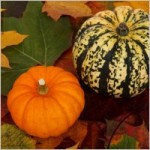 Traditional Chinese medicine recommends eating foods in season to help keep your body in balance with the natural environment. Root veggies and pumpkin are good foods to eat in fall and winter. This hearty, creamy, dairy-free soup is delicious, simple to make, and very soothing on a cold day. Serve by itself or with a slice of good bread. Here is Linda’s recipe:
Traditional Chinese medicine recommends eating foods in season to help keep your body in balance with the natural environment. Root veggies and pumpkin are good foods to eat in fall and winter. This hearty, creamy, dairy-free soup is delicious, simple to make, and very soothing on a cold day. Serve by itself or with a slice of good bread. Here is Linda’s recipe:
INGREDIENTS:
1 small pumpkin (I prefer kabocha pumpkin)
1-2 medium potatoes
1 qt veggie soup stock (or chicken stock), fresh or canned
1 can coconut milk (sometimes called coconut cream)
2-3 tsp freshly grated ginger (or approx. 1/8 to 1/4 tsp ground ginger)
Dash of lime juice
Optional items:
1/2 tsp Thai green chili paste* or Thai red chili paste* or a dash of chili flakes
Cilantro for garnish *available in Asian sections of supermarkets
NOTE: There is plenty of “wiggle room” in this recipe. Ingredient amounts are not exact as the size of pumpkin will vary. It’s much easier to get it “right” than it is to go wrong. Let your taste buds guide you with the seasonings. About the pumpkin peel: kabocha pumpkin peel is soft and tasty so leave it on. Orange “Halloween” pumpkin peel tastes fine on smaller pumpkins but can be tougher and woodier as the pumpkins get larger. If in doubt, peel the orange pumpkin before cooking.
DIRECTIONS:
1. Split pumpkin into halves (click here to learn how), scoop out the seeds, (if using orange pumpkin, peel it if desired,) then chop into cubes.
2. Chop potatoes into cubes. (You may first peel them if desired. I prefer to leave skins on for fiber and nutrients)
3. Place pumpkin, potato and soup stock in a large pot. Boil gently approx. 30 minutes until pumpkin and potato are tender and mushy.
3. Add coconut milk. Stir well. Reduce heat to low.
4. Add ginger and lime juice to taste. Stir. Optional: Add chili paste or chili flakes. Stir.
[Tip: If soup needs more depth to the taste, then add a dash of ground cumin]
5. By now, the soup is thick and creamy. Ladle soup into bowls. Optional: Garnish with fresh cilantro leaves.
6. Enjoy!
Many Common Nutrition “Facts” are Actually Nonsense
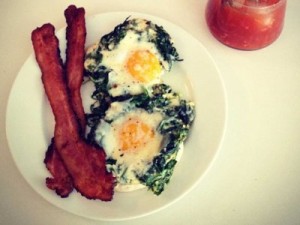
Unfortunately, false nutrition information has spread widely into public knowledge over recent decades, and most of the conventional wisdom regarding nutrition in the USA is wrong. An informative article in the Business Insider describes just 13 of the nutrition mis-facts that are commonly believed to be facts. Here is my summary of the article:
EGGS are among the most healthy foods for humans. Eggs raise your “good” cholesterol and do not promote heart disease. The fat content of eggs promotes weight loss. Eggs are unique in that they contain plenty of healthy fats, protein, vitamins, minerals, and antioxidants. They are a good source of choline which is needed by the brain. Eating eggs for breakfast can eliminate the craving for sweet sugary food in the afternoon and evening.
COFFEE is a very healthy substance. It’s loaded with more antioxidants than fruits and vegetables combined. Caffeine boosts metabolism and improves brain function including memory, reaction time, and mood, Coffee greatly lowers the risk of Type II diabetes, liver disease, Alzheimer’s, and Parkinson’s.
WHOLE WHEAT is the greatest source of gluten in the American diet. In many people, gluten causes gas, bloating, abdominal pain, and fatigue. It can damage the lining of your intestines. Gluten can also contribute to autism and schizophrenia.
SODIUM does not lead to heart disease. Restricting sodium in your diet does not reduce your risk for heart disease. Too little sodium in your diet can lead to high “bad” LDL cholesterol, high triglycerides, insulin resistance, and Type II diabetes,
LOW-FAT, HIGH-CARB diet does not cause you to lose weight, and it can be harmful in people who are overweight or have diabetes.
HIGH-FAT, LOW-CARB diet promotes weight loss.
LOW-CARB diet is very beneficial. It lowers blood pressure, raises “good” HDL cholesterol, and lowers triglycerides. A low carb diet (which is much easier to maintain than a low fat diet) can greatly lower blood sugar and reduce the need for medication in Type II diabetes patients. Low carb diet can prevent obesity, metabolic syndrome, and Type II diabetes.
FATS do not make you fat. Context is key. A diet that is high in both fats and carbs can cause weight gain but it is not from the fats. A diet too low in fats can cause overeating and can cause degenerative diseases. It is best to eat healthy fats everyday. Healthy fats are polyunsaturated essential fatty acids (EFA) found in foods such as salmon, halibut, trout, sardines, flax, walnuts, pumpkin seeds, and grass-fed meat. EFAs are a major source of energy, they promote healthy skin and hair, reduce inflammation, prevent arthritis, cancer and heart disease. They lower triglycerides and “bad” cholesterol to reduce the risk of heart attack and stroke.
SATURATED FATS do not contribute to heart disease. They are completely unrelated to heart disease. They reduce “bad” LDL cholesterol and raise “good” HDL cholesterol
CALORIES are not created equally. Different types of food are broken down and absorbed via different metabolic pathways in the body. A calorie of protein will boost metabolism and muscle mass and reduce appetite much more that a calorie of carbs or fat would. Calories of fructose (cane SUGAR often added to foods) will increase your appetite, causing you to eat more food and gain weight rapidly. It sets you up for metabolic disease. Excess fructose leads to high cholesterol, high triglycerides, insulin resistance, and obesity in as little as 10 weeks. It causes heart disease, Type II diabetes, and cancer, Thus, sugar is not “empty calories”. Conversely, the same amount of calories of glucose (natural sugar found in fruit) lowers your appetite, helping you to feel full and eat less.
PROTEIN increases bone density to lower your risk of broken bones in your older years. In healthy people, protein increases your muscle mass, reduces body fat, lowers your risk for heart disease and diabetes,
For more detailed information about what I’ve written here, see the full Business Insider article: 13 Nutrition Lies That Made The World Sick And Fat
Stretches for Repetitive Strain Injuries
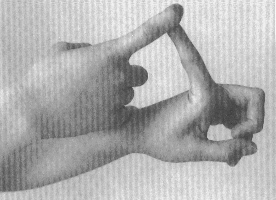 Simple effective stretches to relieve pain and discomfort in your shoulder, forearm, and fingers are featured on the Musician’s Health website with pictures for easy reference. Just click this link to see them: http://www.musicianshealth.com/stretches.htm
Simple effective stretches to relieve pain and discomfort in your shoulder, forearm, and fingers are featured on the Musician’s Health website with pictures for easy reference. Just click this link to see them: http://www.musicianshealth.com/stretches.htm
The stretches (and the photo here at left) are from the book “Repetitive Strain Injuries: Alternative Treatments and Prevention” by Dr. Tim Jameson, DC. These stretches are not just for musicians. They are great for computer users and anyone who performs repetitive tasks as part of your job or hobby, even cooking. If you continue to engage in the tasks that caused the injury, then adding acupuncture to your care routine can bring significant relief and improvement to your shoulders, arms, hands, wrists, and fingers. Contact us if you would like to see how acupuncture can help your body feel more comfortable when performing repetitive tasks.
7 Signs That You Need Acupuncture This Spring
Sharing with you this AcuTake article by Sara Calabro:
7 Signs That You Need Acupuncture This Spring
Tomorrow is the first day of spring. Yahoo! Except for that fact that many people don’t feel so hot this time of year.
The flu is—knock on wood—mostly behind us. Allergies have not quite exploded yet. So, why do so many of us feel off in the early days of spring?
You can kindly thank your Liver!
In acupuncture theory, humans are viewed as microcosms of the natural world that surrounds them. Seasons—particularly the transitional periods, when we move from from one season to the next—factor significantly into how we feel.
Each season is linked with an organ system in the body, and spring’s system is Liver. This means that the Liver, as it adjusts to taking over the seasonal reigns, is especially vulnerable.
When the Liver is vulnerable, the functions throughout the body for which the Liver is responsible have a tendency to get out of whack.
Eventually, spring can become a time when the Liver and its associated functions thrive. However, during this transitional period, when the Liver is still finding its footing, certain symptoms commonly show up. Acupuncture improves these symptoms by restoring balance to the Liver system.
How To Know That You Need Acupuncture
Here are seven signs that your Liver may need some acupuncture love:
You feel extra tense
In acupuncture, Liver is the system that’s responsible for smooth flow throughout the body. When the Liver is not functioning optimally, things like emotional stress, rigid posture, shallow breathing, and jaw clenching may become exacerbated.
You have headaches and other aches and pains
When things aren’t flowing smoothly, we start to experience what acupuncturists think of as stagnation-type symptoms. These include pain, and specifically pain that feels like pressure, tightness or restriction. Tension headaches and menstrual cramps are commonly worse this time of year.
Your muscles are really stiff
The Liver and its associated system, Gallbladder, nourish the body’s connective tissue, tendons and ligaments. You may notice increased stiffness, tension or tightness in your muscles and joints in the coming weeks.
You feel irritable and frustrated
Are you feeling more annoyed than charmed by the springtime sound of chirping birds? The emotional symptoms associated with Liver imbalances mimic the physical stagnation that happens. You may notice yourself feeling extra irritabile or frustrated, perhaps more easily annoyed. There’s an emotional stuckness that can take hold in spring.
Your fuse is shorter than usual
All organ systems in acupuncture have an associated emotion. Liver’s emotion is anger. A healthy dose of anger helps complete a balanced emotional profile. However, when the Liver isn’t appropriately keeping things in check, there is a tendency for anger to rise up. Along with feeling irritable, you may have a harder time than usual controlling your anger.
Your digestion is messed up
Healthy digestion is heavily dependent on consistent and smooth movement throughout the whole body. When the Liver fails to maintain flow, digestive disturbances can easily occur. There’s also the whole brain-gut connection. When emotional stress is higher than usual, digestive function naturally declines.
Your eyes are bothering you
Just as all organ systems have an associated emotion, they also have an associated sense. Sight goes with the Liver system, so any issues related to eye health are usually attributed, at least in part, to a Liver imbalance. This can include poor vision as well as eye pain and fatigue, and dry eyes. This simple exercise can help.
The Springtime Acupressure Point
If you only remember one acupuncture point all spring, it should be Liver 3.

Located on the foot, between the first and second toes (see picture at right), Liver 3 is the source point on the Liver channel.
Source points behave sort of like central stations on subway lines. They are hubs where internal and external energies gather and transform. They are single, high-concentration points that grant access to the larger system.
Any time of year, Liver 3 is a go-to point for stagnation throughout the body. Because of the spring–Liver connection, the point is doubly useful for addressing springtime stagnation-type symptoms.
Applying acupressure to Liver 3 will help get things moving like no other point. Poke around the point area until you discover a tender spot. Liver 3, if pressed firmly enough, is sensitive on most people.
Once you have the point, apply firm pressure. This should feel a little achy. The more the better on this point, so feel free to do this acupressure exercise anytime your bare feet are available. Liver 3 can be pressed on one or both sides.
If in the coming weeks you experience some tell-tale signs of a Liver imbalance, don’t get down on yourself—they’re completely normal during the seasonal transition. A little acupuncture will help realign your system so that you can enjoy the wonders of spring.
Photos by Sara Calabro
Liver 3 infographic from A Manual of Acupuncture
Purple Dragon Welcomes Acupuncturist Manu Saxena
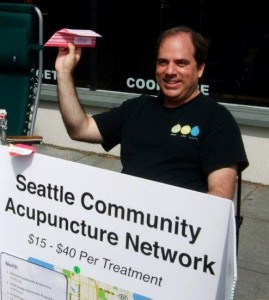 Our newest staff member, Manu Saxena, LAc, EAMP, is taking over the Wednesday afternoon shift 1:00-4:00 so that we can add more evening hours to our clinic. Linda now works Wednesday evenings 4:00-8:00. Since Wednesday is also $5 Acu Happy Hour day, why not drop in for a mini tune-up and meet Manu!
Our newest staff member, Manu Saxena, LAc, EAMP, is taking over the Wednesday afternoon shift 1:00-4:00 so that we can add more evening hours to our clinic. Linda now works Wednesday evenings 4:00-8:00. Since Wednesday is also $5 Acu Happy Hour day, why not drop in for a mini tune-up and meet Manu!
Manu has been a friend of Purple Dragon for sometime. He is a member of the Seattle Community Acupuncture Network (SCAN), and has plenty of experience working in community acupuncture. He is a fine practitioner who has a gentle touch. Manu is well versed in three different styles of acupuncture: traditional Chinese acupuncture, Manaka-style acupuncture (a Japanese style of acupuncture), and Toyohari Meridian-style acupuncture. In addition, Manu has experience with craniosacral therapy and various massage techniques, including Shiatsu and Chinese Tuina, is a Reiki master, and has training in Richard Bartlett’s unique healing method of Matrix Energetics. He specializes in helping people enhance their health with Chinese medicine; individuals with painful musculoskeletal disorders, allergies, emotional challenges like anxiety and depression, and in particular children, are frequent clients. Read more about Manu here.
We wish Christina Williams all the best in her new adventures. It was wonderful to have her working as acupuncturist and massage therapist at Purple Dragon this past year, and we’ll miss her. In fact, it will take 2 people to replace her! Stay tuned for news about our new massage therapist Becky Yawman.




